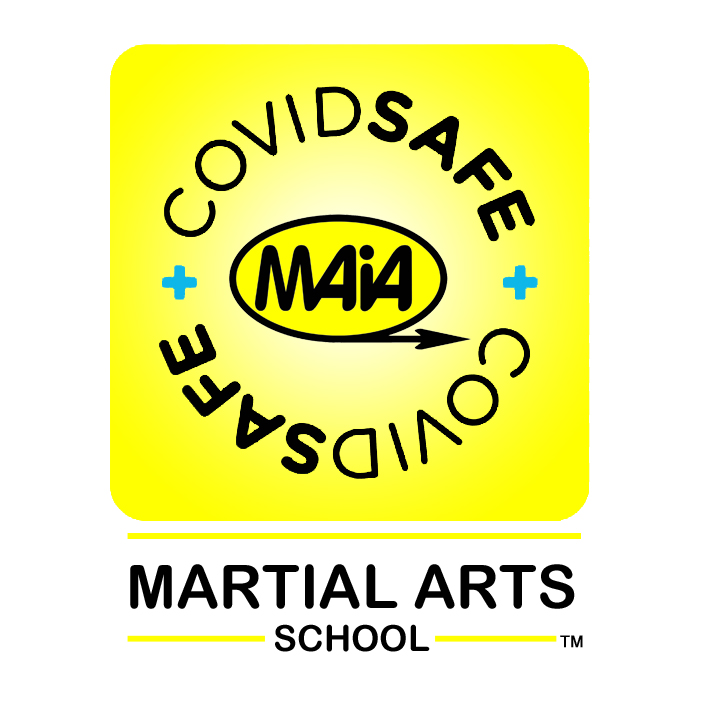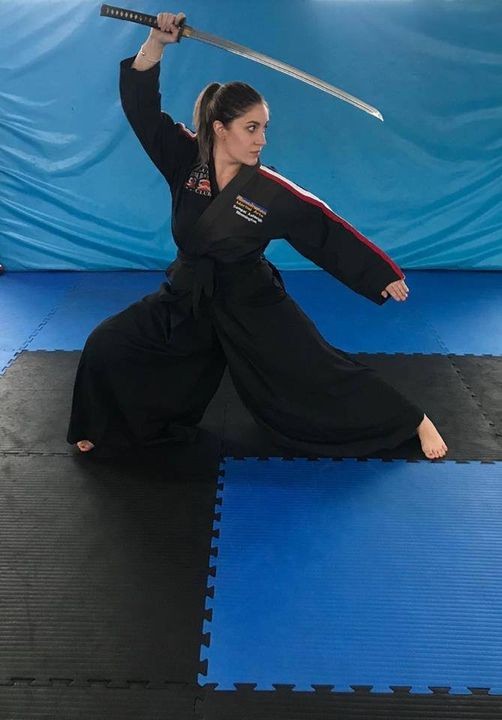Are you wondering about any of the unusual words denoted in the title above? Then, keep reading and you will soon be an expert in the concept of Martial Arts. However, in this case, you will have a sound insight into the award-winning system that is Rimmington Martial Arts.
What exactly are Martial Arts?
Firstly, let us look at what Martial Arts actually are. According to Wikipedia, Martial Arts are:
“codified systems and traditions of combat practiced for a number of reasons such as:
- self-defense
- military and law enforcement applications
- competition
- physical, mental, and spiritual development
- entertainment
- the preservation of a nation’s intangible cultural heritage.”
This definition is a little wordy and could be confusing for some. An easier way to think about Martial Arts is to compare them to football. To hear the word “football” conjures up different meanings to different people. People use “Football” to describe a number of sports including:
- Soccer
- AFL or Australian Football League
- Futsal
- Rugby League
- Rugby Union or
- Gridiron.
Likewise, the term “Martial Arts” is also an “umbrella” term. Therefore, it describes a variety of different sports and fighting or self-defence styles. For instance, common examples include Judo, Taekwondo, Aikido, MMA and Freestyle Martial Arts.
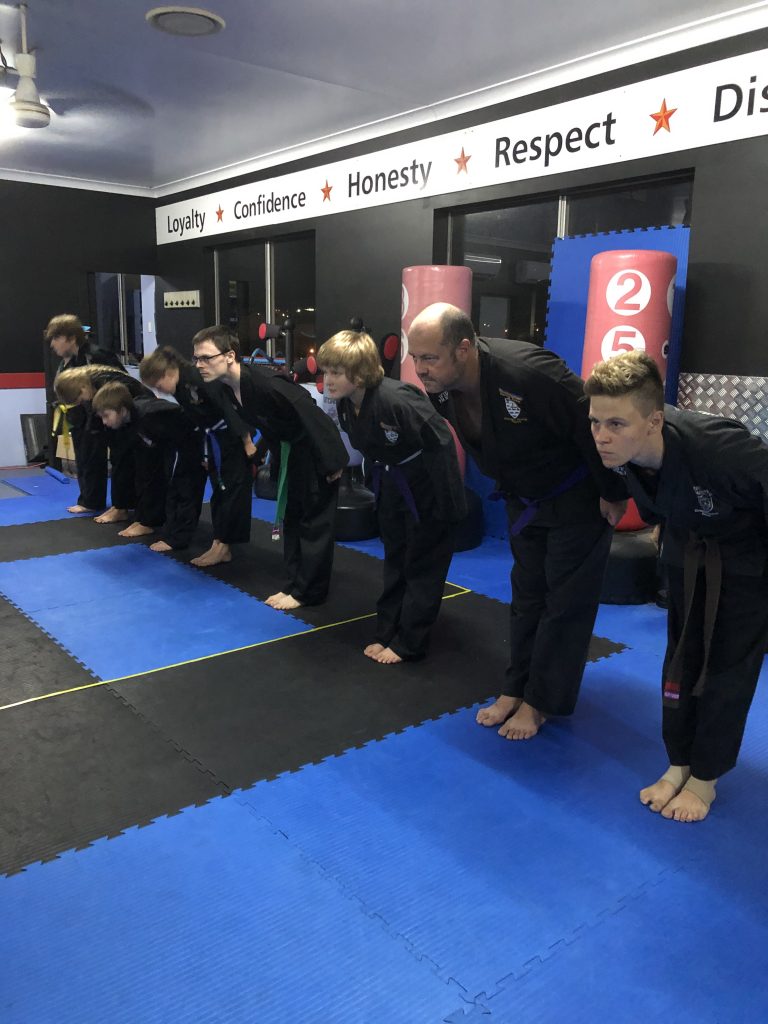
Martial Arts does not mean aggression.
Clearly the keyword in the definition of martial arts is MARTIAL. Originally Martial comes from the word Mars (the Roman God of War). It means warrior-like or related to war. Although a more complex definition relates to unarmed and/or weapons-based training for self-defence. This can be either in civilian or military settings.
Despite the repeated mention of self-defence, these definitions tend to make Martial Arts sound very aggressive. This couldn’t be further from the truth. For the most part, most Martial Artists in today’s society train mainly for other reasons. For example most people train for sport, fitness, to relax, social reasons, and sometimes for competition.
Martial Arts training methods attract people who are not interested in playing team sports. However, they still support the learning of social skills linked with team sports. Such skills include being reliable, solving conflict, confidence and positive self-image.
Benefits of Martial Arts
The benefits of training in the Martial Arts go far beyond the Dojo. Our mission is to deliver effective physical workouts in a safe setting. We strive to make every member feel at ease and confident. Classes not only enhance fitness and teach self-defence techniques, they inspire a state of mental strength and energy.
No two people begin training for exactly the same reason. Common reasons for training in the Martial Arts include:
- Learning to protect yourself and your loved ones
- To have fun
- To meet new people and make life-long friends
- Stress Relief and to relax
- Weight loss
- Gain Condition
- Be more flexible
- Self-Confidence
- Improved Focus
- Self-discipline
- Increased Awareness
- Improved memory
- Be able concentrate better
- Improved Coordination
- Network a Community
Now that we have explained the term Martial Arts, it is time to unravel the mystery of “Rimmington Do”.
Rimmington Do explained
“Dō” just means way, way of, road or path. Hence, Rimmington Do is merely the Rimmington way or style of Martial Arts. Married couple, Trevor and Julie Rimmington founded Rimmington Martial Arts. The pair has been teaching martial arts for over 40 years. Impressive as this seems, along with their all-Black-Belt offspring, the family Martial Arts background well exceeds 100 years in total!
To begin with, the dedicated family of Black Belts trained for decades in various forms of Martial Arts. Later, they established Rimmington Freestyle Martial Arts around the turn of the century. The term “freestyle” has become a common term associated with Martial Arts.
“FREESTYLE” Martial Arts
A Freestyle Martial Art combines multiple styles of Martial Arts to make a better system. This freestyle system combines techniques, philosophies, and characteristics from numerous Martial Arts sources.
Advantages of FREESTYLE Martial Arts
In addition to adaptability, a very strong argument for opting for a Freestyle Martial Art is the comprehensive nature of the curriculum. Put simply, a person trained in both boxing and wrestling will have a better chance of successful self-defence than a person trained in only boxing, or only wrestling. Rimmington Freestyle Martial Arts teaches strategies, techniques, and skills from scores of different fighting and Martial Arts systems. The skill sets that Rimmington Freestyle includes in their system unfolds in more detail later in this article.
For Rimmington Freestyle Martial Arts, being a smaller network allows founders and decision makers to be more in touch with the students. They are hands on, in the Dojo teaching. Therefore, they know what works and what does not. This gives a more immediate and accurate assessment of the efficacy of the system and any adaptations implemented.
The birth of Rimmington Freestyle Martials Arts.
Who
The RMA Freestyle system obviously is very effective and hugely successful, but where did it all begin? The name is the dead give-away here. Trevor and Julie Rimmington developed the freestyle system. They both had their first Martial Arts experiences as teenagers, in Freestyle Martial Arts, Kung Fu and in Judo. Subsequently, in their late teens their interest diverged to BJC Zen Do Kai, now known as BJMA (Bob Jones Martial Arts).
After their Zen Do Kai decades, both Trevor and Julie Rimmington had achieved ranking of 7th Degree (or Dan) Black Belt. They also achieved high ranks as Kickboxing -Muay Thai instructors. In addition, they had trained hundreds of students from beginner through to Black Belt and beyond. Eventually, many of these Black Belts branched out to open subsidiary clubs in other suburbs and cities. Before long, the Rimmingtons were chief instructors to 26 clubs including:
- Freestyle Martial Arts Dojos
- BJC Muay Thai
- Karobics
- BJC Kidz Karate
- BJC Fighting Fit schools.
They also managed other BJC Zen Do Kai clubs from Bundaberg in the North to Brisbane in the South.
Rimmington contribution to Martial Arts
Clearly, Trevor and Julie Rimmington put their heart and soul into their clubs and their students. In addition, their dedication extends to supporting the community as a whole. Hence, they assist the local Police Department with Self-defence seminars, Women’s Safety Seminars, and programs to assist teenage girls at risk. They are also regular volunteers instructing at Women’s Crisis Centres, Rape Crisis Centres, Senior Citizens Centres, Schools and Community Groups.
Furthermore, the Rimmingtons worked to establish the Qld Sport Karate Development Association. This organisation’s aim is to assist Martial Arts students of all styles and ages. Accordingly, the organisation conducts workshops and camps to help all Martial Arts students to improve and progress. To explain, the Rimmingtons invite guest instructors from all styles to provide a broad array of skills for the students to learn. It is a very open-door, welcoming group.
Consequently, Trevor, Julie and Steven Rimmington have each received recognition for their decades of outstanding contribution to the Martial Arts. For example, the International Sport Karate Association inducted each in his/her own merit into the International Sport Karate Association Hall of Fame. https://www.iska.com.au/
On top of this, other awards include multiple long service awards from a horde of organisations, National Fastest Growing Martial Arts School, Best Instructor Awards, Trainer of the Year Awards and Community Service Awards.
Why
Meeting ever changing needs.
During decades of blood, sweat and tears training in the Martial Arts the Rimmingtons witnessed massive changes in attitudes, laws, technology, knowledge and society in general. This is not saying that the “old days” were better, nor does it imply training in today’s society trumps training in the past. Be as that may, society and training are very different today than say 40 years ago. In saying that, it needs to be different. Hence, our training needs to constantly evolve with changes in trends and society’s requirements and expectations.
To expand on some of these differences, let us consider attitudes in society first. Firstly, political correctness, tolerance, acceptance of differences and anti-discrimination have become important core values of our society. Furthermore, our legal system supports these values to promote equal rights for all. These values have strengthened in the 21st century, partly due to increased support of our legal system and education.
No tolerance to bullying.
For example, only a few decades ago, if two school students decided to settle their differences with their fists it was common practice for the friends of each student to stay out of the way or just ensure nobody else became involved. Teachers usually turned a blind eye. In contrast, under the same circumstances today, both students would be receiving counseling, sent to the “reflection” room, suspended from school, perhaps expelled, or any mix of the above. Likewise, in today’s world, there is a strong chance of legal issues and lawsuits as well. This behavior is not accepted and not tolerated.
Cyber bullying
As indicated above there has been a major shift in intolerance to violence and bullying. Bullying has become a significant stressor throughout society in most age categories. Recent trends show new, additional forms of bullying emerging. With easy access to mobile phones and the internet, cyberbullying has reared its ugly head. It has become a powerful weapon for bullies and is proving difficult to curb.
Major modifications to training
These are just some of the issues that instigated a need for a broader, more educated, more effective system of Martial Arts. Extensive study and numerous formal qualifications (to tertiary level) revealed that training techniques and strategies needed major modifications. With over 100 years combined experience training, teaching, competing, and working in the security industry it not surprising we learned what works and what doesn’t.
RMA Freestyle aims to better cater to those who need Martial Arts the most. It focuses on prevention and inclusion. Non-physical attributes, gained through learning Martial Arts, receive more attention. These have been proven to be most beneficial in the safety and general well-being of all students. Students learn skills in a safe environment by qualified instructors who strive to bring out the best in every student. The techniques are effective and appropriate. Student groups are in age categories and experience level. The curriculum design succeeds with age-appropriate systems.
How
It is not hard to imagine the mammoth task it was to professionally forge a whole new system. In designing Rimmington Freestyle Martial Arts, the family left no stone unturned to ensure the end result was an effective, user-friendly system.
? years of experience over 100 years, based on our own experience of works and what doesn’t.
Decades of study and experience in the Martial Arts and related fields enabled the Rimmingtons to consider numerous factors in the design of the comprehensive, new system.
Such factors included:
- What capabilities and skills should a Black Belt student have?
- Which techniques should they be able to execute and at what level of expertise? i.e. What will the curriculum consist of?
- Consider what level of fitness should we require?
- What should they be able to defend against?
- What (if any) adjustments should be made for age differences, young or old? The same question was asked about those with a disability, whether it be physical, psychological, or intellectual.
- In which order should instructors teach the techniques?
- Which techniques do the students need to learn first?
- Pick techniques that novice students capable of learning first?
- Which techniques do the students want to learn first?
- What is the most effective, safe, and user-friendly way to teach the curriculum?
- Does the system cater for everyone?
What makes Rimmington Freestyle Martial Arts so successful?
If it were necessary to describe Rimmington Freestyle Martial Arts in one word, it would need to be “attitude”. The entire system’s designed is to meet the needs of students. We believe Martial Arts are immensely more than just a sport or self-defence system. They provide overall wellness by training and educating the mind, body and spirit.
RMA is a holistic approach to life, reaching far beyond the confines of the Dojo. We provide knowledge, encouragement and mentorship. The Dojo is a safe place for enjoyment and personal growth, through the challenges, discipline and discipline of Martial Arts. Training is both practical and fun. Students benefit from elements of traditional technique and values, hard work ethics, fitness, co-ordination, self-esteem and respect.
What techniques and skills will I learn?
Rimmington Martial Arts is a Freestyle Martial Art. Hence, many of the techniques and skills students learn in classes are the same as students learn in other styles of Martial Arts and fighting systems. Examples include BJMA Zen Do Kai, Judo, boxing, wrestling, kung fu, sumo, Aikido, Muay Thai, Karate, Brazilian Jiu-Jutsu, MMA and Tae Kwon Do.
Being a freestyle Martial Art means RMA focuses on many different techniques and skills. These include hand, elbow, leg and knee strikes, grapples, submission holds, kata and weaponry.
Because the chief instructors of RMA trained and taught for decades in Zen Do Kai, this style influences the techniques taught in RMA. Clearly, though, these techniques appear in the curriculums of dozens of other styles.
As we examine which of the RMA techniques are common to other styles, the sharing of techniques between styles becomes abundantly clear. For example, almost all styles teach how to punch, and most styles teach kicking. The way instructors teach techniques boils down to the style of Martial Arts and the teaching style of the individual instructor in each Dojo.
Techniques RMA and BJMA Zen Do Kai have in common.
Firstly, let us look at the techniques and skills RMA teaches that Zen Do Kai also teaches. Zen Do Kai owes its creation to Bob Jones and Richard Norton. They created it after they left a Japanese Goju Kai Karate Dojo. For this reason, much of the Zen Do Kai curriculum has its roots in Goju Kai Karate. The two styles will therefore have some “lap-over” in curriculum. Thus, RMA has influences not only by BJMA Zen Do Kai but by Goju as well.
This influence was significant in the initial RMA curriculums. However, this soon waned with the inclusion of accumulating techniques, strategies, knowledge, and skill sets from countless other sources. RMA is extremely adaptable and evolves rapidly as the need arises.
Techniques RMA and Judo have in common.
Judo is a sport originating in Japan. It is a derivative of the various martial arts developed and used by the samurai and feudal warrior class. From a standing position, it involves throwing the opponent to the ground and then controlling them.
Rimmington Martial Arts students learn the following in common with Judo students:
- Etiquette
- Breakfalls; for safety when defending or in combat
- Rolls
- Throws
- Controlling the opponent once on the ground; holding or pinning
- Strangles & chokes
- Armlocks
- Joint locks
- Kata: Both styles practice kata, however the kata are not the same.
- Japanese terminology for techniques
RMA differs from Judo in that Judo does not involve kicking, punching, or striking techniques of any kind. In addition, Judo involves no equipment or weapons of any sort. RMA Freestyle endeavors to ensure students practice defence against any attack, with or without weapons. Practice is always in a safe environment, under close supervision, maintaining strict contact control. RMA’s practice of such a wide range of techniques also helps to avoid over-use injuries often sustained in Judo.
Word on the street is Judo can be really harsh on the body. For instance, serious, long term practice of Judo is very likely to cause Osteoarthritis on all fingers from constant GI gripping. To add to this, wrecked cartilage in knees is also common. This is often due to some of the throwing techniques like uchimata or inner-thigh reaping throw.
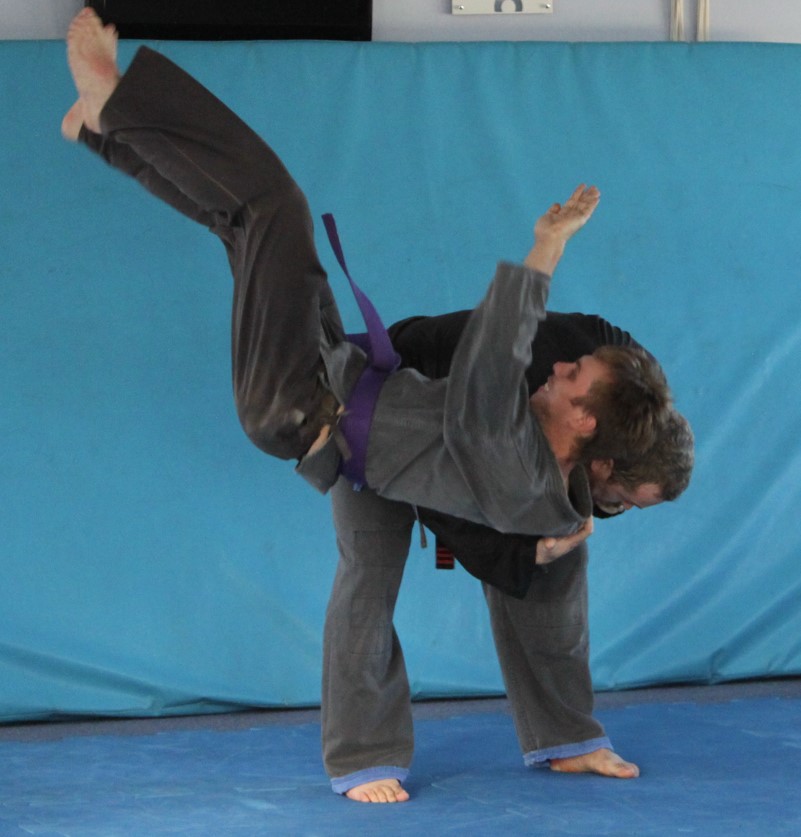
Techniques RMA and Aikido have in common.
The Japanese martial art of Aikido is a system of throwing, joint locking, and controlling/pinning techniques. Aikido often translates as “Way of unifying or harmonizing energy”. The term “aiki” refers to the tactic of blending with an attacker’s movements. The purpose of this is to control their actions with minimal effort. Students apply Aiki by learning to read the rhythm and intent of the attacker. This allows them to find the optimal position and timing to apply a counter technique.
Aikido uses twisting and throwing techniques and aims to turn an attacker’s strength and force against himself. Students also use pressure on vital nerve centres. In theory Aikido’s concept of gaining the best position and timing is valid. Sadly, in the case of real-life situations, these two requirements very rarely come together to allow the theory to work. In spite of that, RMA still teaches these concepts. However, we bear in mind it will take years of practice before we can rely on it fully to save a situation.
Aikido training is based primarily on two partners practicing pre-arranged forms (kata) rather than freestyle practice. Likewise, RMA initially practices similar control drills. Be as that may, the aim of RMA is to progress to more realistic context. In this context, students do not know what their enemies are planning to attack with.
Despite these contrasts in approach, RMA Freestyle uses many of the same skills practiced in Aikido. RMA does teach the use of balance and force. RMA students practice strikes at more intense speeds and power though. Skills used in common include:
- Punches
- Knife hand strike
- Defence from single and double handed grabs of the wrists, shoulders and chest/ lapel
- Wrist-locks
- Throws
- Weapons training, including staff (jō), the wooden sword (bokken), and the knife (tantō).
Skills RMA and Sumo have in common.
Sumo is a style of Japanese wrestling. Most times, it is practiced in a ring about 15 feet (4.6 metres) in diameter. The object is one of two options. Firstly, the aim is to propel the partner out of the ring. The second option, is to force him to touch the ground with any part of his body other than the soles of his feet. To add to this, professional sumo has no weight divisions. Therefore, weight, size, and strength are of the greatest value, though speed and swiftness of attack are also useful.
RMA Freestyle practices Sumo wrestling both for competition and as an effective general skills. In short, it is a tool to teach balance, timing, how to use weight transfer and game plan to help gain the edge. RMA students prefer to wear a karate uniform, Gi, instead of the traditional Japanese loincloth. They also have the comfort of weight divisions. Therefore, the contest is more about skill and strength than weight and size.
Differences between traditional Sumo and RMA Sumo
RMA students practice sumo in class for fun and to learn skills. It is always a welcome session, in a safe, fun setting. They also learn the traditions of the sport such as the start of match rituals. A well timed charge starts the match.
Initially, both wrestlers are in the crouch. Then the referee signals that it is time for the match to begin. Soon after, both wrestlers put one fist on the ground. Then they touch the other fist on the ground. When both wrestlers have touched their second fist on the ground, it is “Go” time. Both wrestlers jump up from the crouch at the same time and charge at each other.
This charge often leads to injury. Therefore, to reduce injuries, RMA and ISKA have changed the rules. The crouch, with both fists touching the ground still applies. Although, we changed the charge. The aim was to reduce injuries in collisions. Instead, both fighters take a two-handed grip on their partner. After the grips are in place, the referee begins the match. RMA students have won titles at international level in this event.
Muay Thai – Kickboxing – RMA – Commonalities.
Kickboxing is the term people commonly use to describe a group of stand-up combat sports, based on kicking and punching. Muay Thai or Thai Boxing can fit into the category of Kickboxing. The main difference is the striking system. Kickboxing uses kicks and punches only or a four-point striking system. On the other hand, Muay Thai is an eight-point striking system. It involves kicks, punches, knees, elbows and also uses the clinch, or upper body grappling.
Muay Thai and Kickboxing both deeply embed in the RMA system. This was a natural progression from the early years of training by Trevor and Julie Rimmington in both kickboxing and Muay Thai while still with the BJC, now called BJMA Muay Thai. The pair also introduced and promoted all the kickboxing and Muay Thai fight nights on the Sunshine Coast and Cooloola regions for almost 20 years. Their training skills and ethos led to countless minor and major titles for their fighters in kickboxing, Muay Thai, and BJMA Muay Thai.
Boxing techniques
Like kickboxing and Muay Thai, Boxing is a classic individual sport. Likewise, it requires a partner in order to compete and a team to prepare. Like RMA, training methods in boxing attract people who are not keen to take up team sports. Each style draws in those who want to be responsible for outcomes.
All the punches students learn in boxing are therefore also in the RMA system. Fighters hands are in a similar position protecting the face. The major difference between the two styles lies in the stances. As rules forbid strikes to the leg in boxing, the lead leg is safe and turned slightly in. This makes it quite at risk from heavy leg kicks in a self-defence event though. Because RMA teaches leg kicks and defence against leg kicks, its stance is more front-on. In addition, it is slightly more shallow and ready to check any attacks on the legs. Further, the hundreds of other techniques that RMA members have at the ready gives them the overwhelming advantage over a boxer.
Wrestling moves
Wrestling is an ancient sport involving grappling moves. The aim is to force the opponent to touch the ground with any part of the body other than the feet, to force him into a certain position, or to hold him in that position. Wrestling competitors attempt to gain and keep the superior position. RMA teaches all of the wrestling techniques in order to “control” an opponent or attacker.
Both RMA and wrestling use a variety of techniques to achieve control including:
- Clinch fighting
- Throws and take-downs
- Joint locks
- Pins
- Catch
- Rides
- Submission
- Reversals and escapes
BJJ or Brazilian Jiu Jitsu skills
Brazilian Jiu-Jitsu is a martial art based on ground fighting and submission holds. Like wrestling, it focuses on taking an opponent to the ground, controlling the opponent, and gaining a dominant position. Then they use techniques to force them into submission via joint locks or chokeholds.
RMA embraces the same concept as BJJ; i.e. that a smaller, weaker person can successfully defend him/herself against a bigger, stronger, heavier opponent. They achieve this by using leverage and weight distribution in the first instance. Following taking the fight to the ground they use a variety of holds and submissions to defeat them.
RMA and Brazilian Jiu-Jitsu share the same training methods. Both systems focus on live drilling and sparring. Students begin practicing drills against a non-resisting partner. Then, they progress to resisting partners and then to full speed and sparring. In sparring, or “rolling”, each student tries to submit their partner through technique. Like BJJ, RMA also practices positional drilling.
Individual techniques taught by both RMA and BJJ include basic ground positions and submissions including:
- Full mount
- Back mount
- Side control
- Knee ride
- North-South position
- A variety of guards
- Chokes (eg. Rear naked choke)
- Joint locks (eg. Arm bars)
- Compression locks
Taekwondo and RMA: Techniques in common
Tae Kwon Do is a Korean martial art. It is characterized by punching and kicking techniques. RMA teaches these same techniques. There is one major difference between the styles of Martial Arts. Namely, Tae Kwon Do puts emphasis on head-height kicks, jumping spinning kicks, and fast kicking techniques. Kicks are of greater importance than punches.
RMA on the other hand focuses on self-defence. Therefore, RMA focuses on hand techniques and protection against hand techniques more than Tae Kwon Do. RMA kicks focus more on power. Tae Kwon Do kicks focus more on speed.. Despite this, all the head-height, jumping spinning kicks Tae Kwon uses, students in RMA learn as well. However, these techniques seldom turn out to be reliable in a self-defence situation. Hence, students concentrate on using them in displays and tournaments.
Both RMA and Tae Won Do practice kata, termed “forms” in Tae Kwon Do.
Techniques commonly used by Kung Fu and RMA
Kung Fu uses many of the same techniques as RMA. The difference is in the performance of the techniques. RMA students carry out techniques in a more linear direction. Conversely, Kung Fu uses a more circular approach.
As do Kung Fu students, RMA students learn the basics of:
- balance
- stances
- stretching
- breathing techniques
- forms
- striking
- throwing
- weapons
There are many stances practiced by both styles. For instance, lunging stances, horse stance and cat stance.
Both RMA and Kung Fu practice katas or forms to perfect technique, focus and balance. Kung Fu katas are modified more for looks and are typically longer katas. RMA kata has power and snap. The movements are crisp and have a distinct stop-and-go motion.
Mixed Martial Arts (MMA) is based on striking, grappling and ground fighting. RMA incorporates all three of these concepts in its curriculum.
MMA describes any style of Martial Arts combining techniques from several other Martial Arts. Hence, RMA is a Mixed Martial Art.
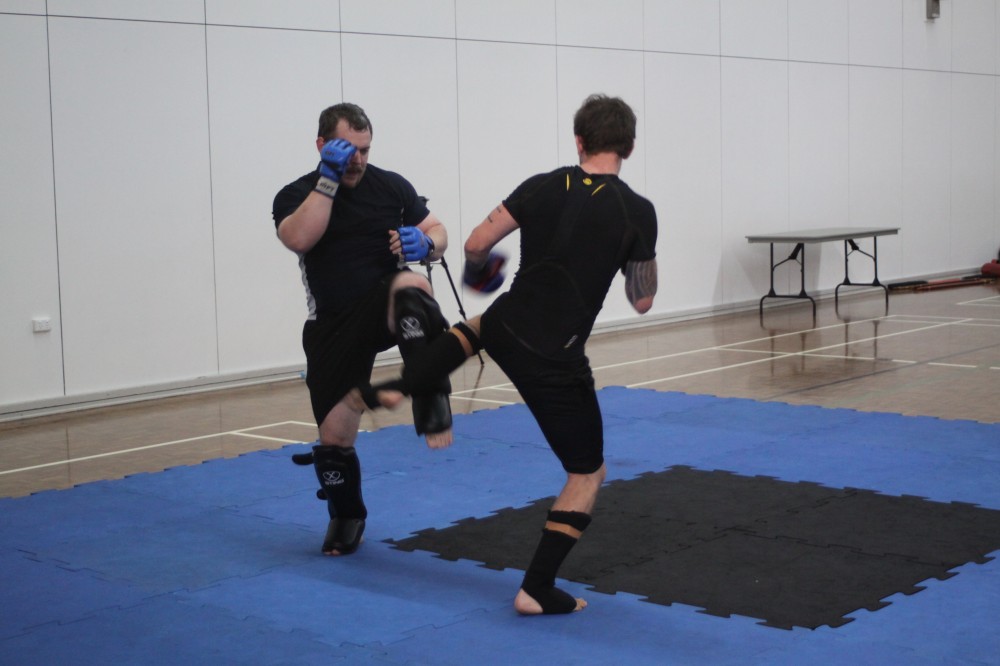
RMA teaches all the concepts and techniques used in competition Mixed Martial Arts; e.g. UFC. This includes a mixture of ground fighting, stand-up striking and grappling and take-downs, techniques such as:
- Striking
- Finishing holds
- Control
- Punches
- Elbows
- Kicks
- Knees
- Joint locks
- Chokes
- Take-downs
- Throws
RMA demands strict control of contact to ensure training is safe for everyone. The use of drills and partner cooperation in learning the techniques proves to be an effective strategy in injury prevention.
